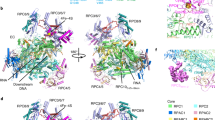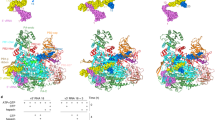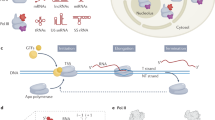Abstract
Structural studies of RNA polymerase II have suggested two possible exit paths for the nascent RNA: groove 1, which points toward the subcomplex of subunits Rpb4 and Rpb7, and groove 2, which points toward Rpb8. These alternatives could not be distinguished previously because less than 10 nucleotides (nt) of transcript were resolved in the structures. We have approached this question by UV cross-linking nascent RNA to components of the transcription complex through uridine analogs located within the first six nucleotides of the RNA. We find that the emerging transcript cross-links to the Rpb7 subunit of RNA polymerase II in various complexes containing 26- to 32-nt transcripts. This interaction is greatly reduced in complexes with 41- or 43-nt RNAs and absent when the transcript is 125 nt. Our results are consistent with groove 1 being the exit path for nascent RNA.
This is a preview of subscription content, access via your institution
Access options
Subscribe to this journal
Receive 12 print issues and online access
$189.00 per year
only $15.75 per issue
Buy this article
- Purchase on Springer Link
- Instant access to full article PDF
Prices may be subject to local taxes which are calculated during checkout



Similar content being viewed by others
References
Cramer, P. RNA polymerase II structure: from core to functional complexes. Curr. Opin. Genet. Dev. 14, 218–226 (2004).
Kettenberger, H., Armache, K.-J. & Cramer, P. Complete RNA polymerase II elongation complex structure and its interaction with NTPs and TFIIS. Mol. Cell 16, 955–965 (2004).
Gu, W., Wind, M. & Reines, D. Increased accommodation of nascent RNA in a product site on RNA polymerase II during arrest. Proc. Natl. Acad. Sci. USA 93, 6935–6940 (1996).
Reeder, T.C. & Hawley, D.K. Promoter proximal sequences modulate RNA polymerase II elongation by a novel mechanism. Cell 87, 767–777 (1996).
Cramer, P. et al. Architecture of RNA polymerase II and implications for the transcription mechanism. Science 288, 640–649 (2000).
Cramer, P., Bushnell, D.A. & Kornberg, R.D. Structural basis of transcription: RNA polymerase II at 2.8 Å resolution. Science 292, 1863–1876 (2001).
Gnatt, A.L., Cramer, P., Fu, J., Bushnell, D.A. & Kornberg, R.D. Structural basis of transcription: an RNA polymerase II elongation complex at 3.3 Å resolution. Science 292, 1876–1882 (2001).
Westover, K.D., Bushnell, D.A. & Kornberg, R.D. Structural basis of transcription: separation of RNA from DNA by RNA polymerase II. Science 303, 1014–1016 (2004).
Todone, F., Brick, P., Werner, F., Weinzierl, R.O. & Onesti, S. Structure of an archaeal homolog of the eukaryotic RNA polymerase II RPB4/RPB7 complex. Mol. Cell 8, 1137–1143 (2001).
Orlicky, S.M., Tran, P.T., Sayre, M.H. & Edwards, A.M. Dissociable Rpb4-Rpb7 subassembly of RNA polymerase II binds to single-strand nucleic acid and mediates a post-recruitment step in transcription initiation. J. Biol. Chem. 276, 10097–10102 (2001).
Ebright, R.H. RNA polymerase: structural similarities between bacterial RNA polymerase and eukaryotic RNA polymerase II. J. Mol. Biol. 304, 687–698 (2000).
Proudfoot, N.J., Furger, A. & Dye, M.J. Integrating rnRNA processing with transcription. Cell 108, 501–512 (2002).
Maniatis, T. & Reed, R. An extensive network of coupling among gene expression machines. Nature 416, 499–506 (2002).
Howe, K.J. RNA polymerase II conducts a symphony of pre-mRNA processing activities. Biochim. Biophys. Acta 1577, 308–324 (2002).
Zorio, D.A. & Bentley, D.L. The link between mRNA processing and transcription: communication works both ways. Exp. Cell Res. 296, 91–97 (2004).
Újvári, A. & Luse, D.S. Newly initiated RNA encounters a factor involved in splicing immediately upon emerging from within RNA polymerase II. J. Biol. Chem. 279, 49773–49779 (2004).
Choder, M. Rpb4 and Rpb7: subunits of RNA polymerase II and beyond. Trends Biochem. Sci. 29, 674–681 (2004).
Bushnell, D.A. & Kornberg, R.D. Complete, 12-subunit RNA polymerase II at 4.1-Å resolution: implications for the initiation of transcription. Proc. Natl. Acad. Sci. USA 100, 6969–6973 (2003).
Meisenheimer, K.M., Meisenheimer, P.L. & Koch, T.H. Nucleoprotein photo-cross-linking using halopyrimidine-substituted RNAs. Methods Enzymol. 318, 88–104 (2000).
Armache, K.-J., Kettenberger, H. & Cramer, P. Architecture of initiation-competent 12-subunit RNA polymerase II. Proc. Natl. Acad. Sci. USA 100, 6964–6968 (2003).
Edwards, A.M., Kane, C.M., Young, R.A. & Kornberg, R.D. Two dissociable subunits of yeast RNA polymerase II stimulate the initiation of transcription at a promoter in vitro. J. Biol. Chem. 266, 71–75 (1991).
Chung, W.H. et al. RNA polymerase II/TFIIF structure and conserved organization of the initiation complex. Mol. Cell 12, 1003–1013 (2003).
Kimura, M., Suzuki, H. & Ishihama, A. Formation of a carboxy-terminal domain phosphatase (Fcp1)/TFIIF/RNA polymerase II (pol II) complex in Schizosaccharomyces pombe involves direct interaction between Fcp1 and the Rpb4 subunit of pol II. Mol. Cell. Biol. 22, 1577–1588 (2002).
Kamenski, T., Heilmeier, S., Meinhart, A. & Cramer, P. Structure and mechanism of RNA polymerase II CTD phosphatases. Mol. Cell 15, 399–407 (2004).
Moore, M.J. Intron recognition comes of AGe. Nat. Struct. Biol. 7, 14–16 (2000).
Zolotukhin, A.S., Tan, W., Bear, J., Smulevitch, S. & Felber, B.K. U2AF participates in the binding of TAP (NXF1) to mRNA. J. Biol. Chem. 277, 3935–3942 (2002).
Blanchette, M., Labourier, E., Green, R.E., Brenner, S.E. & Rio, D.C. Genome-wide analysis reveals an unexpected function for the Drosophila splicing factor U2AF(50) in the nuclear export of intronless mRNAs. Mol. Cell 14, 775–786 (2004).
Robert, F., Blanchette, M., Maes, O., Chabot, B. & Coulombe, B. A human RNA polymerase II-containing complex associated with factors necessary for spliceosome assembly. J. Biol. Chem. 277, 9302–9306 (2002).
Samkurashvili, I. & Luse, D.S. Structural changes in the RNA polymerase II transcription complex during transition from initiation to elongation. Mol. Cell. Biol. 18, 5343–5354 (1998).
Újvári, A., Pal, M. & Luse, D.S. RNA polymerase II transcription complexes may become arrested if the nascent RNA is shortened to less than 50 nucleotides. J. Biol. Chem. 277, 32527–32537 (2002).
Pal, M., McKean, D. & Luse, D.S. Promoter clearance by RNA polymerase II is an extended, multistep process strongly affected by sequence. Mol. Cell. Biol. 21, 5815–5825 (2001).
Pal, M. & Luse, D.S. The initiation-elongation transition: lateral mobility of RNA in RNA polymerase II complexes is greatly reduced at +8/+9 and absent by +23. Proc. Natl. Acad. Sci. USA 100, 5700–5705 (2003).
Pal, M. & Luse, D.S. Strong natural pausing by RNA polymerase II within 10 bases of transcription start may result in repeated slippage and reextension of the nascent RNA. Mol. Cell. Biol. 22, 30–40 (2002).
Werner, F., Eloranta, J.J. & Weinzierl, R.O. Archaeal RNA polymerase subunits F and P are bona fide homologs of eukaryotic RPB4 and RPB12. Nucleic Acids Res. 28, 4299–4305 (2000).
Eloranta, J.J., Kato, A., Teng, M.S. & Weinzierl, R.O. In vitro assembly of an archaeal D-L-N RNA polymerase subunit complex reveals a eukaryote-like structural arrangement. Nucleic Acids Res. 26, 5562–5567 (1998).
Pal, M., Ponticelli, A.S. & Luse, D.S. The role of the transcription bubble and TFIIB in promoter clearance by RNA polymerase II. Mol. Cell 19, 101–110 (2005).
Maldonado, E., Drapkin, R. & Reinberg, D. Purification of human RNA polymerase II and general transcription factors. Methods Enzymol. 274, 72–100 (1996).
Komissarova, N. & Kashlev, M. Functional topography of nascent RNA in elongation intermediates of RNA polymerase. Proc. Natl. Acad. Sci. USA 95, 14699–14704 (1998).
Acknowledgements
We thank F. Werner for human Rpb4 and Rpb7 and the expression constructs to prepare these proteins, M. Gama-Carvalho (University of Lisbon) for the antibody to U2AF65 (MC3), R. Padgett (Cleveland Clinic Foundation) both for an initial gift of the MC3 antibody and for the U2AF-expressing baculovirus, and M. Pal for establishing the protocol for releasing transcription complexes from magnetic beads. We also thank R. Padgett and M. Pal for advice during the course of these experiments. HeLa cells for preparation of nuclear extracts were provided by the US National Cell Culture Center. This work was supported by grant GM 29487 from the US National Institutes of Health.
Author information
Authors and Affiliations
Corresponding author
Ethics declarations
Competing interests
The authors declare no competing financial interests.
Rights and permissions
About this article
Cite this article
Újvári, A., Luse, D. RNA emerging from the active site of RNA polymerase II interacts with the Rpb7 subunit. Nat Struct Mol Biol 13, 49–54 (2006). https://doi.org/10.1038/nsmb1026
Received:
Accepted:
Published:
Issue Date:
DOI: https://doi.org/10.1038/nsmb1026
This article is cited by
-
RNA polymerase II phosphorylation and gene looping: new roles for the Rpb4/7 heterodimer in regulating gene expression
Current Genetics (2020)
-
Sub1/PC4, a multifaceted factor: from transcription to genome stability
Current Genetics (2017)
-
The X-ray crystal structure of the euryarchaeal RNA polymerase in an open-clamp configuration
Nature Communications (2014)
-
Architecture of the RNA polymerase-Spt4/5 complex and basis of universal transcription processivity
The EMBO Journal (2011)
-
RNA pol II subunit RPB7 is required for RNA pol I‐mediated transcription in Trypanosoma brucei
EMBO reports (2009)



